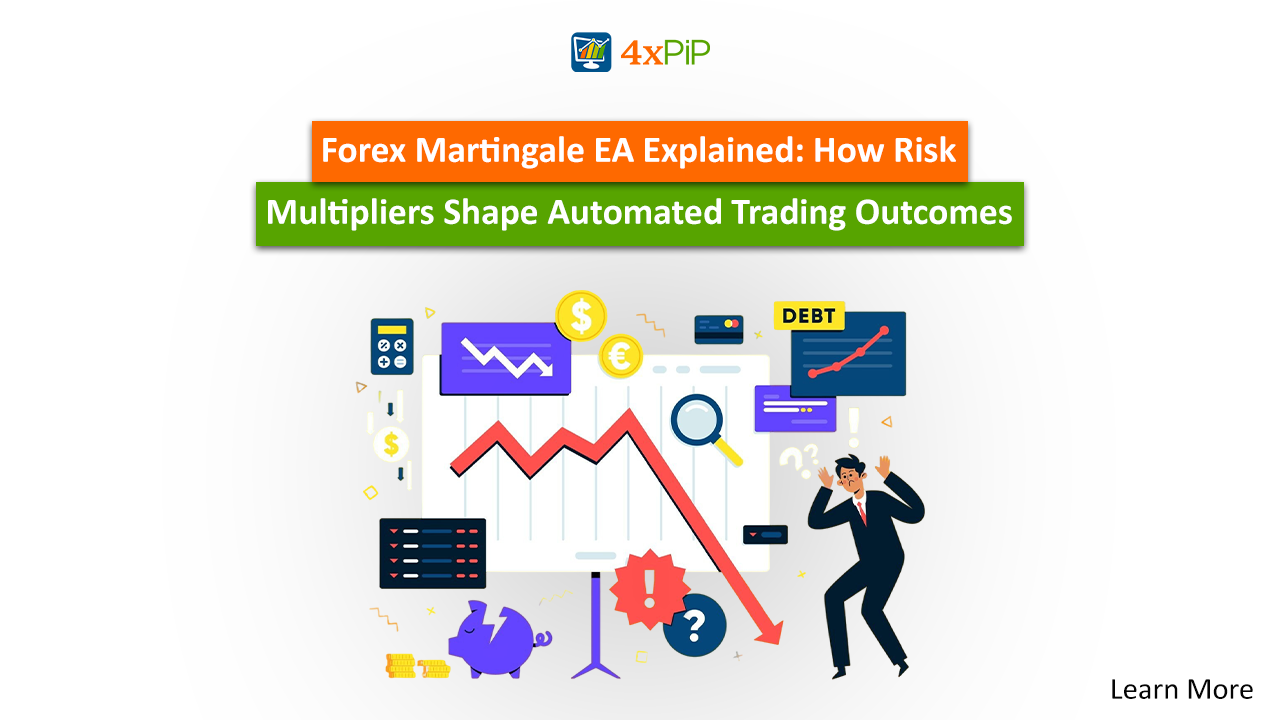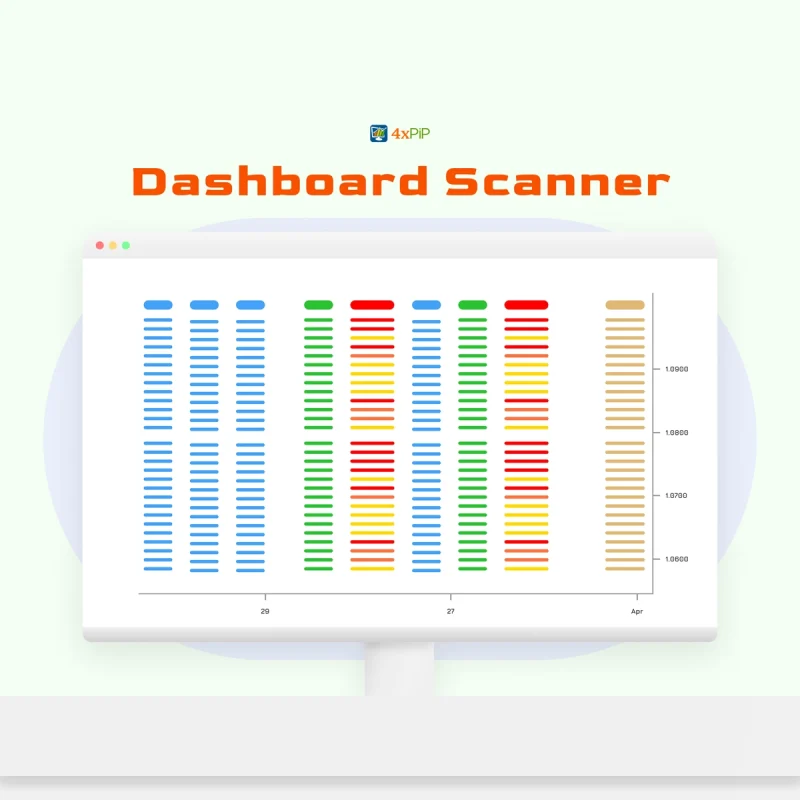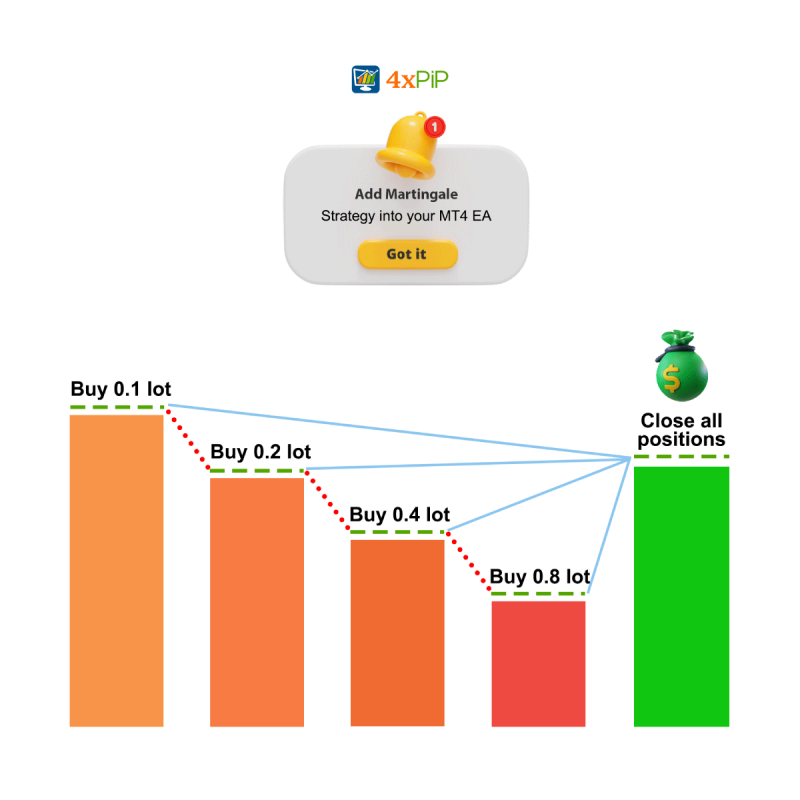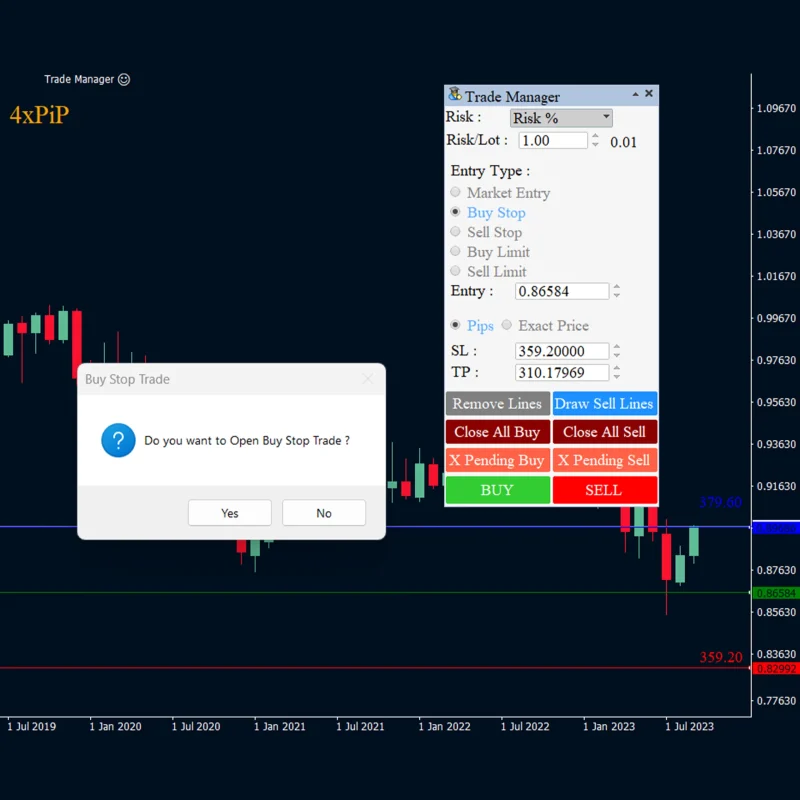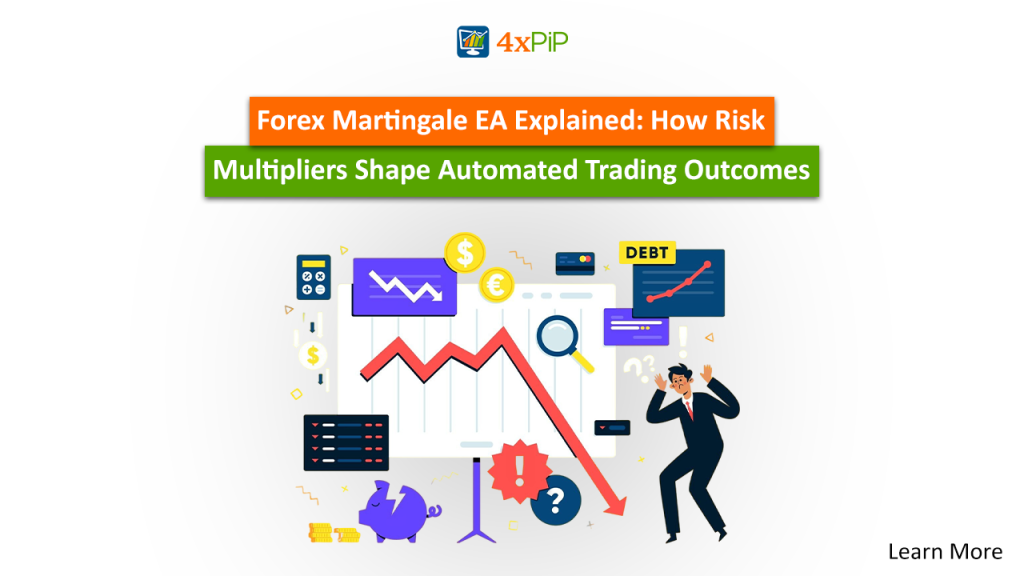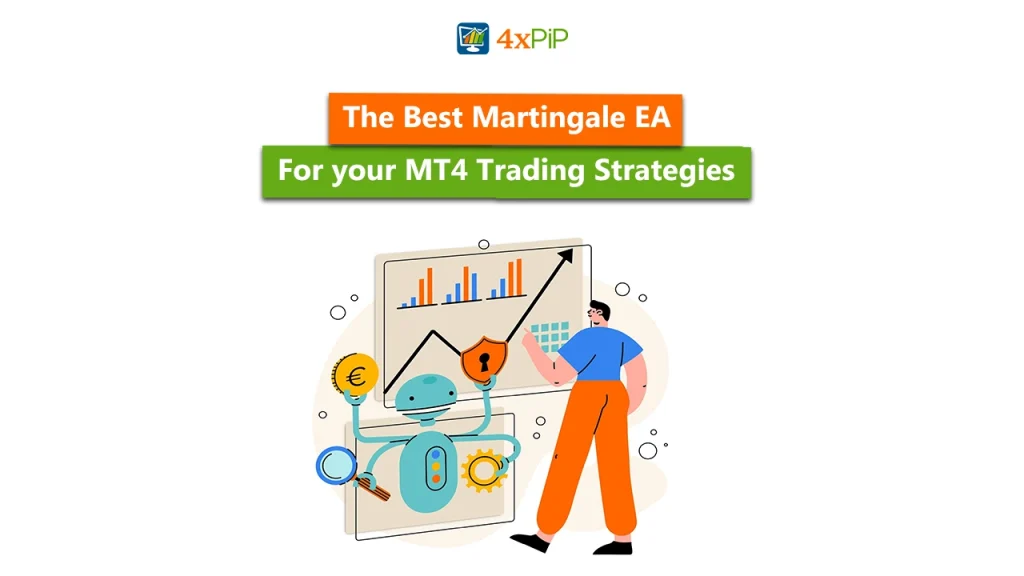A Forex Martingale EA is an automated trading bot that applies the Martingale principle, increasing position size after each losing trade to recover previous drawdowns and close the sequence in overall profit. This method uses risk multipliers to adjust lot size dynamically, turning a string of losses into a single net gain when the market corrects. The logic relies on grid spacing, incremental lot progression, and centralized profit targeting to maintain equity balance. However, while it can accelerate recovery, it also amplifies exposure, making lot management and step size configuration extremely important. The 4xPip Martingale EA automates this entire process with adjustable multipliers and built-in equity protection.
The Logic Behind Martingale Systems

The Martingale strategy is rooted in 18th-century probability theory, originally designed to recover losses by doubling the bet size after each losing round. In Forex trading, the same principle is applied through position scaling, each new trade increases in lot size after a losing position to recover prior drawdowns and secure a net profit once price reverses. The system’s core logic is simple but powerful: recovery through controlled risk multiplication. However, while theoretically sound, its effectiveness in live markets depends on factors like margin capacity, volatility conditions, and the trader’s ability to manage exposure across consecutive positions.
Modern EAs add this logic mathematically, transforming traditional Martingale recovery into automated precision. Instead of manual re-entries, algorithms evaluate lot progression, grid distance, and centralized take profit to control recovery flow. Our Martingale EA demonstrates how this principle can be optimized for real-world trading by integrating safety caps, margin protection, and adaptive multipliers. These refinements preserve the original concept’s intent, like systematic recovery, while aligning it with the risk constraints and execution accuracy required in modern automated trading.
The Role of Risk Multipliers in Position Sizing
A risk multiplier in EA settings defines how much the lot size increases after each losing trade, directly controlling the intensity of recovery in a Martingale sequence. For example, setting the multiplier to 1.5x means each subsequent trade is 50% larger than the last, while 2x or 3x doubles or triples exposure respectively. This scaling accelerates recovery but also compounds margin requirements, each increment consumes more equity and margin capacity. If not balanced properly, aggressive multipliers can deplete available margin faster than the market can correct, especially during extended price trends. A disciplined setup involves calibrating the multiplier in proportion to account size, available margin, and grid spacing to maintain sustainability across volatile conditions.
4xPip’s Martingale EA refines this concept through precise lot management and centralized take profit logic. Our EA automatically calculates the correct lot size for each Martingale order based on your chosen multiplier and grid steps, ensuring every trade sequence targets a net profit while managing drawdown efficiently. For instance, when users set an initial lot of 0.1 and a multiplier of 2, the system automatically scales positions going 0.1 → 0.2 → 0.4 → 0.8, until the group of trades closes in profit. This balance of automated lot progression, technical analysis, and recovery logic allows traders to apply multipliers strategically rather than blindly, maintaining profitability without overexposing the account.
How Martingale EAs Manage Equity Drawdowns and Recovery Phases
Drawdowns in Martingale systems occur when consecutive trades move against the initial order, forcing each subsequent trade to open with a larger lot size. As exposure compounds, floating losses deepen, and margin usage accelerates. The equity curve dips sharply during these losing streaks until the reversal occurs. At that point, all open trades are grouped and closed at a centralized take-profit level, recovering accumulated losses in a single cycle. The aggressiveness of the multiplier directly determines drawdown depth, for instance, a 3x multiplier will recover losses faster but also amplify capital strain if the trend extends. Hence, optimal configuration means balancing multiplier size, grid spacing, and maximum trade count relative to account equity.
Our Martingale EA addresses this challenge through a built-in recovery mechanism that opens counter trades during adverse movements to minimize drawdown. It dynamically adjusts the centralized take-profit level based on the total exposure of all active trades, ensuring that the entire set closes in profit once equilibrium returns. This systemized equity control allows traders to sustain recovery phases with reduced volatility, making equity management an added part of the strategy rather than an afterthought.
Common Risk-Control Techniques in Modern Martingale Algorithms
Modern Martingale EAs integrate multiple layers of risk control to keep exposure sustainable during adverse market moves. Developers use equity stops, progressive multipliers, and partial close logic to prevent cascading losses. Equity stops define a maximum drawdown limit, halting all trading once it’s reached. Progressive multipliers, unlike fixed ones, gradually increase lot sizes based on market strength instead of doubling after each loss, reducing the chance of exponential exposure. Partial close logic lets the EA lock in profits from profitable positions while keeping the recovery sequence active. Many advanced models also combine Martingale with grid or averaging techniques to spread entries more evenly, smoothing drawdown and reducing the average break-even distance. In volatile or high-impact sessions, volatility filters and news filters pause the EA to avoid unpredictable price spikes, keeping execution stable and consistent.
With the 4xPip Martingale EA, users can apply all these protections effortlessly. The EA’s recovery mechanism, centralized take-profit, and stop-out percentage settings are designed to cap exposure automatically. To start, install the bot on MetaTrader, set your initial lot size, choose a multiplier or lot increment, and define your maximum Martingale trades. The EA will manage spacing, recovery, and drawdown dynamically. You can also enable the time filter to control trading hours and use the stop-out percentage as a safety net. For traders who want additional control, 4xPip allows customization, simply share your strategy with our development team, and we’ll build the risk logic to your trading style. This ensures your Martingale execution isn’t just profitable, it’s intelligently protected from the very risks that make this strategy challenging.
Evaluating Performance Metrics: Beyond Profit and Loss
Profit alone doesn’t define a Martingale system’s strength, stability metrics tell the real story. Key measures like maximum drawdown, recovery factor, and profit factor reveal how efficiently an EA manages risk and rebounds after losses. Maximum drawdown shows the worst equity decline during testing, while recovery factor compares net profit to that drawdown, indicating resilience. A higher profit factor (total gross profit divided by total gross loss) reflects consistent returns relative to risk. Relying on win rate is misleading in Martingale systems because position sizing can inflate it, a 99% win rate means little if one losing sequence wipes the account. Instead, traders should focus on how controlled the EA’s recovery cycles and margin usage remain under prolonged volatility.
4xPip’s Martingale EA makes this analysis easier by displaying running trade profits, trade count, and history profit directly on the MetaTrader chart. To evaluate your setup, load the EA, set your initial lot size, multiplier, and maximum Martingale trades, then run a backtest to observe how the strategy handles drawdowns and recovery phases. Once satisfied, transition to forward testing on a demo account to confirm live performance under different volatility levels. Our EA’s built-in technical analysis, centralized take-profit logic, and auto-adjustment of SL/TP ensure that test results align closely with live conditions. By comparing these metrics across sessions, traders can refine settings for long-term stability instead of chasing short-term profit spikes.
Interpreting Martingale Outcomes in Real-World Market Conditions
In live markets, factors like slippage, liquidity, and execution delay can cause Martingale strategies to behave differently from their backtest results. For instance, during volatile sessions, order execution might occur a few pips away from the intended price, altering the spacing between trades and skewing recovery timing. When liquidity thins, spreads widen. And since Martingale EAs depend on precise grid spacing and lot multiplication, even small deviations can compound risk exposure. Traders assessing long-term viability must consider both margin availability and their psychological capacity for deep equity swings. While Martingale systems can recover quickly after drawdowns, sustainability depends on maintaining consistent margin levels and predefined stopout thresholds that prevent cascading losses.
To start evaluating this in practice, install the 4xPip Martingale EA on MetaTrader and open a demo account to simulate live execution conditions. Set your initial lot size, lot multiplier, and Martingale orders under realistic broker spreads, then enable the centralized takeprofit feature to observe how grouped trades close collectively in profit. The EA’s auto adjustment of SL/TP and technical analysis–driven entries make it easier to assess real-time efficiency without manual recalibration. As you monitor performance, gradually expand to higher timeframes or wider grid spacing to gauge stability across liquidity shifts. By doing so, you can translate theoretical expectations into measurable live outcomes while refining your personal risk tolerance and multiplier control.
Summary
A Forex Martingale EA automates one of the oldest recovery-based trading methods, increasing position size after losses to recover drawdowns and close the cycle in profit. Using risk multipliers, it dynamically adjusts lot size and grid spacing to control exposure while targeting equity balance. When configured properly, it can accelerate recovery and compound gains; however, when misused, it can also amplify losses. The key to success lies in smart configuration, balancing multiplier size, grid distance, and equity management. 4xPip’s Martingale EA refined this process with adaptive multipliers, equity protection, and centralized take-profit logic, allowing traders to build their own trading bot for MT4, MT5, or TradingView that prioritizes both performance and safety.
4xPip Email Address: [email protected]
4xPip Telegram: https://t.me/pip_4x
4xPip Whatsapp: https://api.whatsapp.com/send/?phone=18382131588
FAQs
- What is a Forex Martingale EA?
It’s an automated bot that increases trade size after losses, aiming to recover drawdowns and close all positions in overall profit once the market reverses. - How does the Martingale strategy work in Forex?
It multiplies position size after each losing trade. When price reverses, the larger position offsets earlier losses and secures a net gain. - What are risk multipliers in a Martingale EA?
Risk multipliers determine how much lot size increases after a loss, such as 1.5x, 2x, or 3x, directly influencing recovery speed and exposure. - Why is lot and grid spacing important?
Proper spacing ensures trades are distributed across price ranges, helping control drawdown and prevent excessive margin use during volatile trends. - Can Martingale systems be safe?
Yes, when risk is managed carefully. Features like equity stops, partial closes, and progressive multipliers limit exposure while maintaining recovery potential. - What factors affect a Martingale EA’s performance in live trading?
Execution delays, slippage, liquidity, and spread changes all impact order timing, affecting grid spacing and recovery accuracy. - How does 4xPip’s Martingale EA improve traditional setups?
It automates lot scaling, centralized take-profit, and margin protection. Built-in filters and stop-out settings prevent uncontrolled drawdowns. - What metrics best evaluate Martingale EA performance?
Key ones include maximum drawdown, profit factor, and recovery factor. These show how efficiently the EA manages risk and rebounds from losses. - How should traders test their Martingale EAs?
Start with backtesting to check logic, then forward-test on a demo account to assess live conditions, execution speed, and spread variation. - Can I build my own Martingale bot for MT4, MT5, or TradingView?
Absolutely. With 4xPip’s custom development services, you can share your trading logic, and we’ll convert it into a fully functional, risk-managed EA made for your strategy.

